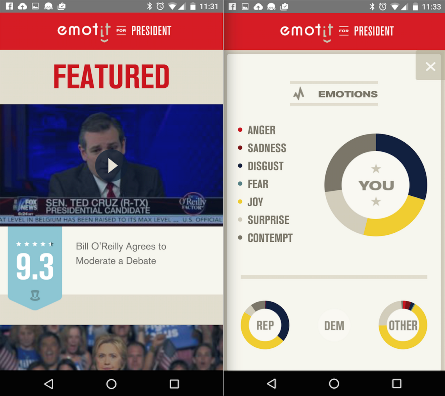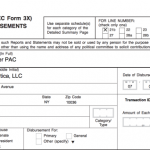New “Emotit for President” app measures your emotional response to Clinton, Trump et al.
using Affectiva’s facial reputation tech, the makers of the ooVoo multi-person video/messaging platform want to turn mobile units into political thermometers.

Two reveal pictures of Emotit. On the left, a clip of Republican Senator Ted Cruz is it sounds as if in reality liked (9.3) through Democrats (blue).
suppose you felt disgusted by using one thing you noticed Donald Trump say on tv.
it’s possible you’ll surprise: hiya, am I most effective the one?
that question is the incentive behind Emotit for President, a new and free cell app released lately to “take the temperature of voters.”
Its maker is Krush, the Dayton, Ohio-based totally firm at the back of ooVoo, a multi-person video chat and messaging platform that claims greater than one hundred fifty million users worldwide. founded closing yr, the company has additionally released a free-rotation VR simulation pod referred to as Moveo.
within the Emotit app, a user indicates gender, ZIP code and whether he/she is a Democrat, Republican or “other.” The app — now on Android, soon on iOS — then displays brief, curated 15- to 30-2d video clips from a day-to-day-updated library on the subject of america presidential race.
With user consent, the app employs facial popularity technology from M.I.T. Media Lab spinoff Affectiva. Fifteen micro-expressions from completely different components of the face of a user looking at the clip are captured throughout the digicam of the identical smartphone or tablet showing the clip. Affectiva then assesses to what stage the user is expressing one or more of seven emotions: anger, sadness, disgust, worry, joy, surprise or contempt.
After the clip is proven, the app shows in real time a ranking that signifies whether or not there used to be a normally sure or terrible response by using all viewers — high is certain— in addition to the user’s ranking. A midpoint arrow presentations the second within the clip the place the person displayed the strongest response, or where the average of all customers did, and the user can immediately leap to that spot. There’s also a map exhibiting which elements of the us principally “liked” or “disliked” the clip.
at the least that’s the theory.
within the faraway demo I saw, the first clip shown used to be from a newscast, so the reporter’s commentary, B-roll shots and different content material were mixed in with photographs from a political gathering. It’s troublesome to know whether an emotional response to this sort of mixed clip used to be to the reporter’s take, the political content, the opposite photographs or some or the entire above. Krush Chairman JP Nauseef told me the clip library contains news clips and “common political parodies,” but “eighty to ninety percent” are just of the candidate.
Then the demo confirmed a clip just of former Secretary of State Hillary Clinton. The response score confirmed an eight.eight sure response — however amongst self-declared Republicans! And Democrats showed a bad rating of 1.zero.
Infinity of conditions
this type of knowledge may dramatically change forecasts of the race, but Nauseef mentioned the sample team of customers within the testing phase used to be simply too small for the rating to represent a sound dimension of basic tendencies.
Then there’s the difficulty of cellular capture in an infinity of stipulations. Affectiva says on its web site that it money owed for variations as a result of gender, eyeglasses, head pose and lighting fixtures conditions, however these variations clearly influence capture in methods that are not obviously defined.
Affectiva also notes that some emotional expressions — pleasure, disgust, contempt and surprise — are the most adequately detected, while anger, sadness and fear are “more nuanced and refined and subsequently tougher to observe leading to scores at the decrease finish of the [accuracy] vary.” So, for those who’re angered via one thing Trump or Clinton stated, it could not be effectively registered.
ultimately, there’s the topic of exactly what the rating and the arrow exhibit. The demo and the announcement, as an example, have described the ranking as representing “certain or poor feelings.”
but which of the seven analyzed thoughts — anger, unhappiness, disgust, fear, pleasure, surprise and contempt — are sure in addition to pleasure? Is shock poor or positive? Are anger, sadness, disgust, fear and contempt all negative? Krush directed me to the Affectiva website, which deals no clarification.
similarly, it’s not clear what the midpoint arrow is meant to indicate. I was once variously advised it was where “the most meaningful emotional connection happened,” or that it was “probably the most enticing,” “the most interesting,” “probably the most preferred,” “the top second” or “essentially the most excessive” point in the clip.
In my e book, these are all very various things.
Nauseef informed me that his company has no plans for earning profits on Emotit by the time the election rolls around, although he did point out they’re in discussion with several unnamed political groups and campaigns. The trade variation, he introduced, would possibly focus on selling the anonymized emotional data that indicates responses to particular content material, which he in comparison with a focus staff. He mentioned that no facial imagery is recorded or saved.
Facial acceptance for marketers
indisputably, emotional detection through facial popularity is catching on as a well-liked software for marketers. Affectiva claims more than 1,400 brands as purchasers. In January, London-based totally main media agency MediaCom announced that it might use emotional measurement from Realeyes — a key Affectiva competitor — as a regular part of its content trying out and media planning.
also in January, Apple announced it had purchased emotion-detection startup Emotient. Late last year, visible engagement analytics platform Sticky added emotional tracking to its eye-monitoring services. And video advert platform Virool launched a platform in 2015 for measuring emotional responses to its advertisements.
whereas a lot of the point of interest for emotional monitoring has been on commercials, it was once best a subject of time prior to content material was once in a similar way put to the test, as Krush is doing. but unless the terminology is more persistently used, the capture stipulations extra standardized and the accuracy better validated, one wonders if the united states’s already white-sizzling political scene — the place one wild ballot throws a information cycle into a tizzy — benefits from such temperature-taking.
Nauseef is an investor in Affectiva and is on its board, and early ultimate 12 months, Krush released an SDK referred to as “wise Video” so that apps could utilize the facial acceptance tech. another Krush app, flinch, offers an Affectiva-powered staring contest, and a in shape-making game also built around emotional reactions is within the works.
(Some pictures used underneath license from Shutterstock.com.)
advertising Land – web advertising information, methods & pointers
(23)














